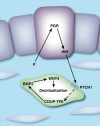Minireview: Steroid-regulated paracrine mechanisms controlling implantation
- PMID: 25051170
- PMCID: PMC4154240
- DOI: 10.1210/me.2014-1074
Minireview: Steroid-regulated paracrine mechanisms controlling implantation
Abstract
Implantation is an essential process during establishment of pregnancy in mammals. It is initiated with the attachment of the blastocyst to a receptive uterine epithelium followed by its invasion into the stromal tissue. These events are profoundly regulated by the steroid hormones 17β-estradiol and progesterone. During the past several years, mouse models harboring conditional gene knockout mutations have become powerful tools for determining the functional roles of cellular factors involved in various aspects of implantation biology. Studies using these genetic models as well as primary cultures of human endometrial cells have established that the estrogen receptor α, the progesterone receptor, and their downstream target genes critically regulate uterine growth and differentiation, which in turn control embryo-endometrial interactions during early pregnancy. These studies have uncovered a diverse array of molecular cues, which are produced under the influence of estrogen receptor α and progesterone receptor and exchanged between the epithelial and stromal compartments of the uterus during the progressive phases of implantation. These paracrine signals are critical for acquisition of uterine receptivity and functional interactions with the embryo. This review highlights recent work describing paracrine mechanisms that govern steroid-regulated uterine epithelial-stromal dialogue during implantation and their roles in fertility and disease.
Figures




Similar articles
-
Dysregulation of EGF family of growth factors and COX-2 in the uterus during the preattachment and attachment reactions of the blastocyst with the luminal epithelium correlates with implantation failure in LIF-deficient mice.Mol Endocrinol. 2000 Aug;14(8):1147-61. doi: 10.1210/mend.14.8.0498. Mol Endocrinol. 2000. PMID: 10935540
-
The progesterone receptor regulates implantation, decidualization, and glandular development via a complex paracrine signaling network.Mol Cell Endocrinol. 2012 Jun 24;357(1-2):108-18. doi: 10.1016/j.mce.2011.10.028. Epub 2011 Nov 17. Mol Cell Endocrinol. 2012. PMID: 22115959 Free PMC article. Review.
-
Uterine kisspeptin receptor critically regulates epithelial estrogen receptor α transcriptional activity at the time of embryo implantation in a mouse model.Mol Hum Reprod. 2021 Sep 29;27(10):gaab060. doi: 10.1093/molehr/gaab060. Mol Hum Reprod. 2021. PMID: 34524460 Free PMC article.
-
COUP-TFII mediates progesterone regulation of uterine implantation by controlling ER activity.PLoS Genet. 2007 Jun;3(6):e102. doi: 10.1371/journal.pgen.0030102. PLoS Genet. 2007. PMID: 17590085 Free PMC article.
-
Role of uterine stromal-epithelial crosstalk in embryo implantation.Int J Dev Biol. 2014;58(2-4):139-46. doi: 10.1387/ijdb.130348mb. Int J Dev Biol. 2014. PMID: 25023679 Free PMC article. Review.
Cited by
-
A hypoxia-induced Rab pathway regulates embryo implantation by controlled trafficking of secretory granules.Proc Natl Acad Sci U S A. 2020 Jun 23;117(25):14532-14542. doi: 10.1073/pnas.2000810117. Epub 2020 Jun 8. Proc Natl Acad Sci U S A. 2020. PMID: 32513733 Free PMC article.
-
miR-181b-5p Modulates Cell Migratory Proteins, Tissue Inhibitor of Metalloproteinase 3, and Annexin A2 During In Vitro Decidualization in a Human Endometrial Stromal Cell Line.Reprod Sci. 2017 Sep;24(9):1264-1274. doi: 10.1177/1933719116682877. Epub 2016 Dec 21. Reprod Sci. 2017. PMID: 28256954 Free PMC article.
-
Progesterone-Regulated Endometrial Factors Controlling Implantation.Am J Reprod Immunol. 2016 Mar;75(3):237-45. doi: 10.1111/aji.12473. Epub 2016 Jan 24. Am J Reprod Immunol. 2016. PMID: 26804062 Free PMC article. Review.
-
Bushen Huoxue Recipe Alleviates Implantation Loss in Mice by Enhancing Estrogen-Progesterone Signals and Promoting Decidual Angiogenesis Through FGF2 During Early Pregnancy.Front Pharmacol. 2018 May 15;9:437. doi: 10.3389/fphar.2018.00437. eCollection 2018. Front Pharmacol. 2018. PMID: 29867455 Free PMC article.
-
Chronic exposure to bisphenol a impairs progesterone receptor-mediated signaling in the uterus during early pregnancy.Receptors Clin Investig. 2016;3(3):e1369. doi: 10.14800/rci.1369. Epub 2016 Jul 21. Receptors Clin Investig. 2016. PMID: 28239613 Free PMC article.
References
-
- Bazer FW, Spencer TE, Johnson GA, Burghardt RC, Wu G. Comparative aspects of implantation. Reproduction. 2009;138:195–209 - PubMed
-
- Finn C. The implantation reaction. In: Wynn R, ed. Biology of the Uterus: New York, NY: Springer US; 1977:245–308
Publication types
MeSH terms
Substances
Grants and funding
LinkOut - more resources
Full Text Sources
Other Literature Sources
Research Materials
Miscellaneous

